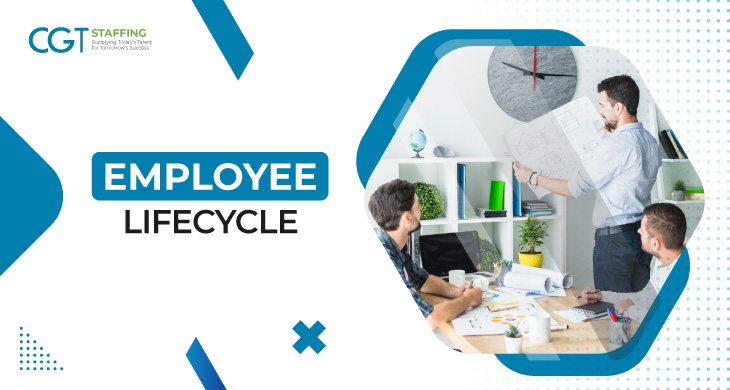In today’s rapidly evolving business landscape, attracting, nurturing, and retaining top talent has become a paramount concern for organizations across all industries. The journey of any employee is never a linear path; rather, it is a dynamic process comprising distinct stages. These stages, collectively known as the employee lifecycle, encompass the span of an employee’s association with a company, from initial attraction to eventual departure.
Understanding and effectively managing each stage is crucial for fostering a healthy and productive workforce. Discover the seven stages of the employee lifecycle and explore why they matter.
Table of Contents
Attraction
The employee lifecycle begins with the attraction stage, in which a potential candidate commences their employee journey with your organization. At this stage, your company’s employer brand, job postings, and recruitment efforts play a pivotal role. A compelling employer brand can significantly impact your ability to attract top talent. Candidates are more likely to be drawn to organizations that offer a positive company culture, growth opportunities, and have a reputation for employee satisfaction.
Attraction slays the groundwork for your organization to acquire the best talent available. Effective talent acquisition and recruitment strategies not only bring in skilled individuals; they also ensure a high level of motivation and alignment with your company’s values and goals.
Recruitment
Once the attraction phase has succeeded in drawing potential candidates, the recruitment stage comes into play. This stage involves the assessment of candidates, interviews, and ultimately, selecting the right individuals to join your team. For both centralized and decentralized recruitment models, acquisition strategies should be well-defined, and the process should be comprehensive such that you ensure hiring of the most suitable candidates.
Effective recruitment ensures that you bring in individuals who possess the skills and qualifications needed to excel in their roles. A strong recruitment process helps reduce turnover, contributes to overall organizational success, and mitigates the risk of hiring an insubordinate employee.
Onboarding
The onboarding stage of the employment lifecycle is crucial for integrating new employees into the organization. This is the time in which new hires are integrated into the organization, introduced to its culture, values, and expectations, and provided with the necessary tools and training to succeed. A well-structured onboarding program can significantly impact an employee’s initial experience with your company and their resulting long-term engagement.
Proper onboarding and communication during final interview questions can reduce turnover rates, improve employee satisfaction, and accelerate the time it takes for new hires to become productive contributors to the organization.
Development
This ongoing stage of the employee lifecycle encompasses various aspects of development, including continuous learning, skill enhancement, and career growth opportunities. Organizations that invest in employee development not only foster a motivated and engaged workforce but also ensure that their employees remain competitive in their respective fields.
Employee development is essential for retaining top talent. When employees see opportunities for growth and advancement within the organization, they are more likely to stay committed and contribute their best efforts.
Engagement
Engaged employees are emotionally committed to their work, resulting in higher productivity, improved customer service, and increased profitability for the organization. Engaging employees involves creating a positive work environment, recognizing their contributions, and providing opportunities for collaboration and growth.
Engaged employees are more likely to stay with the organization, reducing turnover costs and enhancing overall workplace satisfaction.
Retention
Retaining valuable employees is often more cost-effective than constantly recruiting and training new ones. The retention stage involves efforts to ensure that employees are satisfied with their roles, compensation, and work-life balance. This stage also includes identifying and addressing potential issues that may cause employees to consider leaving.
High employee turnover can be detrimental to an organization, leading to increased recruitment and training costs, a loss of institutional knowledge, and decreased team morale. Effective retention strategies can help mitigate these risks.
Departure
The final stage of the employee lifecycle is the departure. An employee may leave an organization for various reasons, including personal growth, career opportunities elsewhere, or retirement. While it might seem counterintuitive to consider the departure stage, it is crucial for organizations to manage it efficiently. Exit interviews, knowledge transfer, and maintaining positive relationships with departing employees are all vital aspects of this stage that contribute to successful employee lifecycle management.
How an organization, whether from mortgage staffing or any other industry niche, handles employee departures can have a lasting impact on its reputation and future recruitment efforts. A positive departure experience can lead to alumni becoming brand advocates and potential returnees in the future.
Conclusion
The employee lifecycle represents a comprehensive framework for managing the entire span of an employee’s journey within an organization. Each stage holds its unique significance, and the successful management of these stages collectively contributes to an organization’s success. By recognizing the importance of each stage and implementing strategies to optimize them, organizations can build a talented, engaged, and loyal workforce that drives growth and innovation. In the ever-competitive landscape of modern business, mastering the employee lifecycle is a strategic imperative for long-term success.
